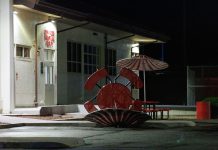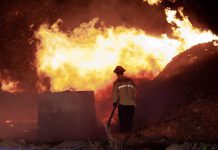The 2007 Crop Report showed an overall 8 percent gain in gross
income over the previous year, but San Benito County Agriculture
Commissioner Matulich described the 2008 season so far as
”
terrible.
”
Hollister
The 2007 Crop Report showed an overall 8 percent gain in gross income over the previous year, but San Benito County Agriculture Commissioner Matulich described the 2008 season so far as “terrible.”
Rationed water, the driest spring in recorded history and high fuel prices have combined to make operating a farm or ranch a difficult prospect this year.
The high price of diesel, up about $1.78 a gallon over this time last year in California, is the main source of farmers and ranchers’ difficulties difficulties, locals say. That jump also has led to sharp increases in costs for such commodities as pesticides and fertilizers, for which local farmers have estimated hikes over last year of more than 70 percent. Throw in water rations caused by drought conditions and protection of the delta smelt in the Sacramento-San Joaquin River Delta, and farmers have a lot more to consider than gross crop values.
At the root of the problem, with an average of $5 a gallon for big rigs that get about 5 miles to the gallon, it’s not too hard to imagine the magnitude of their frustrations.
“A load of manure cost around 150 bucks last year,” Matulich said. “This year they are paying $300 or $400 a load. I drive around these days and see a lot of fields are fallow. They can’t afford to put the crops in.
“The way I look at it right now, there is going to be a significant decrease in the 2008 Crop Report.”
Mari Rossi of B&R farms couldn’t agree more.
“Those fuel prices have a huge effect on our ability to provide the country with our wonderful vegetables,” she said. “It makes it very hard for any farmer.”
Even for some of the area’s most recent success stories, such as Pietra Santa Winery.
“It’s not only the cost of fuel,” said Alessio Carli, Pietra’s head olive oil and wine maker. “Everything went up.”
Carli just finished ordering what he needs for the 2008 grape harvest, expected at the end of August or early September. He estimated an overall 10 percent increase in those costs over last year, and consumers likely will see the effect as well, as Carli predicted a price hike on many varieties of wines next year.
The trickle-down effect of fuel prices particularly hitting many farmers hard has been fertilizers, noted Anthony Botelho, a county supervisor and San Juan Valley apple orchardist.
He estimated fertilizer costs have doubled over the last two or three years while washing out what Botelho described as a moderate value increase over a year ago.
Botelho, in response, has focused on stricter, self-imposed conservation methods. The key, he said, is “not wasting anything.”
“Without question, I know for our farming business, we don’t put any fertilizer on or spray unless it truly merits it,” he said.
Many are having an even more difficult time, noted Kay Filice of Filice Farms, who also projected fertilizer costs for her business have jumped by 70 percent to 80 percent over a year ago.
“More and more farmers are struggling just to keep their businesses alive,” she said.
One of the biggest problems heading into 2009, Filice said, is the water shortage caused by dry conditions and the federal government’s concerns about protecting the “threatened” 2-inch delta smelt fish.
The “simplest answer” is that leaders must examine potential for new storage areas, but she recognized the agriculture industry would have to “cut through a lot of red tape” to make that happen.
She expects the “lowest storage levels we’ve ever had” in 2009, and Filice noted how the federal government this year diverted about 650,000 acre-feet of water into the Pacific Ocean just to protect the threatened fish.
“That didn’t go to ag,” she said. “That didn’t go to people in that state who need it.”
Due to the “blue valve” cutbacks to San Benito County farmers in response, Matulich pointed out how cattlemen have cut back herd sizes and farmers have reduced crop levels.
“The blue valve water is reduced, and a lot of these natural springs have dried up,” he said. “So cattlemen have to truck in water for their herds sometimes, and that gets expensive fast.”
Some farmers have gone back to using their older wells, or looking to drill new ones, but that also comes with its own set of difficulties.
“If you want to go back to well water, a lot of these old wells have collapsed,” Matulich said. “If you want to drill a new one, folks are having to wait on a six-month waiting list and then pay around $125 a foot to drill.”
Rossi of B&R Farms knows all of this firsthand.
“The lack of water changes your whole planting schedule, and there is bare ground out there this year. The blue valve water reductions have hurt us all. We just hope that people remember where their food comes from, and support local farmers.”
Matulich said government leaders and grocery businesses should do more to help curtail the severity of these tough times.
“The government needs to figure out who is feeding everyone and lend a hand. The grocery stores should be paying more also. You wonder who is pocketing all the money. A carton of 24 heads of lettuce is sold for three or four bucks, and then they turn around and sell each head at a buck apiece.”










